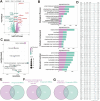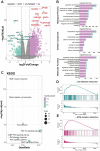Constructing a mitochondrial-related genes model based on machine learning for predicting the prognosis and therapeutic effect in colorectal cancer
- PMID: 40317411
- PMCID: PMC12049353
- DOI: 10.1007/s12672-025-02462-x
Constructing a mitochondrial-related genes model based on machine learning for predicting the prognosis and therapeutic effect in colorectal cancer
Abstract
The role of mitochondria in tumorigenesis and progression is has been increasingly demonstrated by numerous studies, but its prognostic value in colorectal cancer (CRC) remains unclear. To address this, we developed a mitochondrial-related gene prognostic model using 101 combinations of 10 machine learning algorithms. Patients in the high-risk group exhibited significantly shorter overall survival time. The high-risk group exhibited elevated tumor immune dysfunction and exclusion score, indicating diminished immunotherapy efficacy. To address the suboptimal treatment outcomes in these patients, we identified PYR-41 and pentostatin as potential therapeutic agents, which are anticipated to enhance therapeutic efficacy in the high-risk group. Additionally, four biomarkers (HSPA1A, CHDH, TRAP1, CDC25C) were validated by quantitative real-time PCR, with significant expression differences between normal intestinal epithelial cells and colon cancer cells. Our prognostic model provides accurate CRC outcome prediction and guides personalized therapeutic strategies.
Keywords: Biomarkers; Colorectal cancer; Machine learning; Mitochondrion; Prognosis.
© 2025. The Author(s).
Conflict of interest statement
Declarations. Competing interests: The authors declare no competing interests.
Figures








Similar articles
-
A CLRN3-Based CD8+ T-Related Gene Signature Predicts Prognosis and Immunotherapy Response in Colorectal Cancer.Biomolecules. 2024 Jul 24;14(8):891. doi: 10.3390/biom14080891. Biomolecules. 2024. PMID: 39199281 Free PMC article.
-
Machine learning-based integration develops an immune-related risk model for predicting prognosis of high-grade serous ovarian cancer and providing therapeutic strategies.Front Immunol. 2023 Apr 5;14:1164408. doi: 10.3389/fimmu.2023.1164408. eCollection 2023. Front Immunol. 2023. PMID: 37090728 Free PMC article.
-
Integration of machine learning for developing a prognostic signature related to programmed cell death in colorectal cancer.Environ Toxicol. 2024 May;39(5):2908-2926. doi: 10.1002/tox.24157. Epub 2024 Feb 1. Environ Toxicol. 2024. PMID: 38299230
-
Robust machine-learning based prognostic index using cytotoxic T lymphocyte evasion genes highlights potential therapeutic targets in colorectal cancer.Cancer Cell Int. 2024 Jan 31;24(1):52. doi: 10.1186/s12935-024-03239-y. Cancer Cell Int. 2024. PMID: 38297270 Free PMC article.
-
Developing a machine learning-based prognosis and immunotherapeutic response signature in colorectal cancer: insights from ferroptosis, fatty acid dynamics, and the tumor microenvironment.Front Immunol. 2024 Jul 15;15:1416443. doi: 10.3389/fimmu.2024.1416443. eCollection 2024. Front Immunol. 2024. PMID: 39076986 Free PMC article.
References
-
- Sung H, Ferlay J, Siegel RL, Laversanne M, Soerjomataram I, Jemal A, Bray F. Global cancer statistics 2020: GLOBOCAN estimates of incidence and mortality worldwide for 36 cancers in 185 countries. CA Cancer J Clin. 2021;71(3):209–49. - PubMed
-
- Maida M, Macaluso FS, Ianiro G, Mangiola F, Sinagra E, Hold G, Maida C, Cammarota G, Gasbarrini A, Scarpulla G. Screening of colorectal cancer: present and future. Expert Rev Anticancer Ther. 2017;17(12):1131–46. - PubMed
-
- Siegel RL, Wagle NS, Cercek A, Smith RA, Jemal A. Colorectal cancer statistics, 2023. CA Cancer J Clin. 2023;73(3):233–54. - PubMed
-
- Chinopoulos C, Adam-Vizi V. Mitochondria as ATP consumers in cellular pathology. Biochim Biophys Acta. 2010;1802(1):221–7. - PubMed
LinkOut - more resources
Full Text Sources
Research Materials
Miscellaneous
